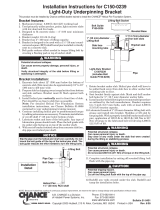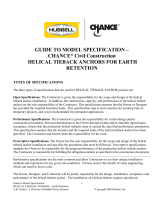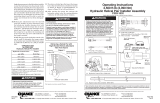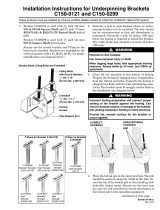Page is loading ...

Page 1 of 27
©Copyright 2006 Hubbell Printed in USA Hubbell Power Systems, Inc. Centralia, MO 65240 USA Bulletin 01-9204
Rev. 10/06
Anchor Corrosion
Reference & Examples
* Available from National Association of Corrosion Engineers, 1440 South Creek Drive, Houston, TX 77084.
Introduction
Corrosion is a naturally occurring process whereby the surface of a metallic structure is oxidized or reduced to a
corrosion product such as “rust” (typically iron oxide). The metallic surface is attacked through the migration of
ions and loses its original strength by the thinning of the member. When corrosion eventually destroys a sufficient
amount of the structure’s strength, a failure will occur. The failure may be as simple as a blemish on an auto body
to a catastrophic failure of a bridge. The purpose of this bulletin is to answer typical corrosion questions in the
case of anchors buried in soil. It is by no means a definitive study, it is some typical cases to give the reader a bet-
ter understanding of subsurface corrosion. A corrosion engineer should be consulted for site specific solution when
there is a significant probability of corrosion.
Much of this work is taken from the NBS circulator 579, April 1, 1957 (O.P.)* by Melvin Romanoff. The tables have
been reconstructed in a more usable format and included in the Appendices. The reader is encouraged to obtain
his own copy and make his own tables.
In our experience, the vast majority of square shaft and pipe shaft anchors have a calculated service life well in
excess of the design life (generally 50 or 100 years) of the structure. In highly corrosive soils and areas of stray
currents (e.g., transmission pipelines and DC railroads) additional measures must be taken to protect the anchor.
A typical anode selection calculation is included in Appendix B.
Background
Mechanical, physical, and chemical properties must be considered in the use of metals. Mechanical and physical
properties are more clearly defined, and usually expressed, in terms of constants. The chemical properties of a metal
are dependent on environmental conditions. The corrosion control industry has grown considerably, in the past 20
years, because metals or alloys are still largely selected for their mechanical and physical qualities alone.
Electrochemistry is the study of metals as they relate to their environment. Corrosion can be defined as the dete-
rioration of a metal due to its interaction with that environment. The exact mechanism of the corrosion process
taking place at the metal-environment interface is highly complex. However, the study of electrochemistry teaches
us that several conditions must be present before the corrosion mechanism takes place. These are:
1. Two points (or areas) on a metallic structure must differ in electrical potential (anode
and
cathode).
2. The anode and cathode must be electrically connected.
3. The electrically connected anode and cathode must be immersed in a common electrolyte
(soil, water or solution).
When these conditions exist, oxidation of the metal (anode) and reduction of a species in solution (oxidizing agent
at the cathode) occur with consequent electron transfer through the metal from the anode to the cathode. Metal
at the anode will be consumed, while metal at the cathode is protected from corrosion damage. The amount of
metal lost is directly proportional to the DC current flow. For mild steel, the metal loss has been determined to be
approximately 20 pounds per amp year. (Typical currents encountered are of the magnitude of 10-5 to 10-3 amps.
The amount of corrosion current that eventually flows is a function of the anode to the cathode area relationship,
circuit resistance, and the electrical potential between the anode and cathode.

Page 2 of 27
Bulletin 01-9204 ©Copyright 2006 Hubbell Printed in USA Hubbell Power Systems, Inc. Centralia, MO 65240 USA
Rev. 10/06
Type Characteristics
Uniform or near uniform Corrosion takes place at all areas of the metal at the
same, or similar, rate.
Localized Some areas of the metal corrode at different rates than
other areas due to heterogeneties in the metal or
environment. This type of attack can approach pitting.
Pitting Very highly localized attack at specific areas, resulting
in small pits that may penetrate to perforation.
Considerations need to be applied as to the types and rates of corrosion anticipated, and the function of the metal
in question. Certain forms of corrosion can be tolerated, but uniform corrosion will be our concern here.
Depending on its physical and metallurgical nature, and on the prevailing environmental conditions, corrosion can
affect a metal in several different ways. Some of these types are listed below:
Soil Environments
Soils constitute the most complex environment known to metallic corrosion. Corrosion of metals in soil can vary
from fairly rapid dissolution to negligible effects. Moisture in soils will probably have the most profound affect when
considering corrosivity than any other variable. No corrosion will occur in environments that are completely dry.
Water is required in soils for ionization of the oxidation process and ionization of soil electrolytes. Flowing water
is a more severe enviromnent than stagnant water.
See Figure 1 for a typical moisture content-soil resistivity curve, in this case, a clay.
Figure 1.
Resistivity versus
Moisture Content
(Romanoff, 1957)

Page 3 of 27
©Copyright 2006 Hubbell Printed in USA Hubbell Power Systems, Inc. Centralia, MO 65240 USA Bulletin 01-9204
Rev. 10/06
Most all soils are heterogeneous. This results in different environments interacting on different parts of the metal
surface, and produces differences in electrical potential. Differences in oxygen, acidity, and salt content also give
rise to corrosion cells.
Soil resistivities (conductivity) are extremely important as they can be corrosion rate controlling. Lower resistivi-
ties (high conductivity) can generate high corrosion rates. Metals that are buried will generally be anodic in a low
resistivity soil, and cathodic at an adjacent high resistivity soil. Soil heterogeneity in conjunction with specific
resistivity, is the most important aspect of soil corrosion. The following table may serve as a guide in predicting
the corrosivity of a soil with respect to resistivities alone:
Soils are generally classified according to their particle size. The general classifications are broken down into sand,
silt, and clay. Included with the mineral particles are organic matter, moisture, gases and living organisms. Soil
pore space will contain either water or gases. Fine textured soils, such as clays, are more tightly packed and have
less pore capacity, thus they are less permeable. Sand on the other hand, has a greater pore space and, hence, is
more permeable.
An example of helix life based on uniform corrosion rates is given in Appendix A. This example calculation should
only be used to estimate the service life of an unprotected anchor (i.e., without cathodic protection in a homoge-
nious soil).
As noted earlier, corrosion rate is a function of soil water content. Table 1 in Appendix A gives pH and conductivity
based on laboratory tests of saturated soil samples. Table 2 of Appendix B is a tabulation of typical soil resistivities
as measured in the field. Temperature, pressure, soil texture and composition also affect corrosion rate. Depth of
the soil sample is affected by all four of these factors. Table 4 is a detailed description of soil profile at each of the
test sites given.
The writer feels that resistivity, as measured by the 4-pin method, at the specific site is the best measurement in
that it “integrates” the resistivity of the entire soil profile. Such a measurement is superior to estimates based on
values taken from the appended tables.
Corrosion Control
One of the methods to control corrosion damage is to electrically isolate the metallic surface from the electrolyte.
Coatings are used in this regard to retard the flow of corrosion current into the soil. If it were possible to apply,
and keep a 100% watertight seal over a buried structure, corrosion problems would be solved. However, complete
isolation is not practical and usually not possible due to holidays or pin holes in the coating. Damage during anchor
installation is also inevitable.
Galvanized coatings protect the underlying structure in two ways. Initially, they provide a protective layer between
the metal and the environment. Secondly, this type of coating will provide cathodic protection (galvanic action)
to exposed surfaces. This sacrificial action will result in depletion of the zinc coating in more aggressive environ-
ments.
Asphaltic coatings or paints only provide physical protection from the environment. At coating holidays, a small-
anode to large-cathode area relationship probably will exist. Corrosion activity would be expected to be highly
localized where the metal is exposed, or the anode area.
Classification Soil Resistivity Anticipated Corrosivity
(Ohm-cm)
Low Resistance 0 - 2,000 Severe
Medium 2,000 - 10,000 Moderate
High 10,000 - 30,000 Mild
Very High Above 30,000 Unlikely

Page 4 of 27
Bulletin 01-9204 ©Copyright 2006 Hubbell Printed in USA Hubbell Power Systems, Inc. Centralia, MO 65240 USA
Rev. 10/06
For very aggressive environments, a good procedure to minimize or eliminate corrosion activity is to apply cathodic
protection in conjunction with coatings. Cathodic protection is a method of eliminating corrosion damage to a struc-
ture by the application of DC current. The effect of this current is to force the metallic surface to become cathodic
(i.e., collecting current). If this current is of sufficient magnitude, all metallic surfaces will become cathodic to the
external anode.
Both sacrificial (galvanic) and impressed current (rectifier and ground bed) cathodic protection systems are used to
provide this current. If the current source is derived from a sacrificial metal (magnesium and zinc are the two most
common galvanic anodes used in soils), the effectiveness will depend on the soil properties in which it is placed.
More available current is generated from a sacrificial anode in low resistant soils than high resistant soils. It is
also desirable to place impressed current anode beds in lower resistant soils. However, since the available driving
potential is greater (rectifier control), the soil resistivity is less significant.
Current requirements needed to protect a structure from corrosion vary, due to physical and environmental fac-
tors. These requirements could range from 0.01 ma/ft2 of metal surface for a well-applied, high-dielectric-strength
plastic coating to 150 ma/ft2 for bare steel immersed in a turbulent, high-velocity, salt-water environment. In soil,
1 ma/ft2 is typically used as the required current to protect steel.
An anode selection problem is given in Appendix B.

Page 5 of 27
©Copyright 2006 Hubbell Printed in USA Hubbell Power Systems, Inc. Centralia, MO 65240 USA Bulletin 01-9204
Rev. 10/06
Appendix A
Table A1: Corrosion of Buried Steel Samples
Table A2: Corrosion of Galvanized Pipe
Table A3: Loss in Weight of Zinc Plate
Sample Calculation on Expected Helix Life

Page 6 of 27
Bulletin 01-9204 ©Copyright 2006 Hubbell Printed in USA Hubbell Power Systems, Inc. Centralia, MO 65240 USA
Rev. 10/06
Table A1: Corrosion of Buried Steel
(abstracted from NBS Cir. 579 Tables 6, 8 and 13)
Location
Resistivity
Ohm-cm DrainagepH
Duration
of Exposure
Years
Loss in Wt.
oz./ft.2
No. Soil
NBS Test Site

Page 7 of 27
©Copyright 2006 Hubbell Printed in USA Hubbell Power Systems, Inc. Centralia, MO 65240 USA Bulletin 01-9204
Rev. 10/06
Table A1: Corrosion of Buried Steel
(abstracted from NBS Cir. 579 Tables 6, 8 and 13)
Location
Resistivity
Ohm-cm DrainagepH
Duration
of Exposure
Years
Loss in Wt.
oz./ft.2
No. Soil
NBS Test Site

Page 8 of 27
Bulletin 01-9204 ©Copyright 2006 Hubbell Printed in USA Hubbell Power Systems, Inc. Centralia, MO 65240 USA
Rev. 10/06
Table A1: Corrosion of Buried Steel
(abstracted from NBS Cir. 579 Tables 6, 8 and 13)
Location
Resistivity
Ohm-cm DrainagepH
Duration
of Exposure
Years
Loss in Wt.
oz./ft.2
No. Soil
NBS Test Site

Page 9 of 27
©Copyright 2006 Hubbell Printed in USA Hubbell Power Systems, Inc. Centralia, MO 65240 USA Bulletin 01-9204
Rev. 10/06
Table A1: Corrosion of Buried Steel
(abstracted from NBS Cir. 579 Tables 6, 8 and 13)
Location
Resistivity
Ohm-cm DrainagepH
Duration
of Exposure
Years
Loss in Wt.
oz./ft.2
No. Soil
NBS Test Site

Page 10 of 27
Bulletin 01-9204 ©Copyright 2006 Hubbell Printed in USA Hubbell Power Systems, Inc. Centralia, MO 65240 USA
Rev. 10/06
Table A1: Corrosion of Buried Steel
(abstracted from NBS Cir. 579 Tables 6, 8 and 13)
Location
Resistivity
Ohm-cm DrainagepH
Duration
of Exposure
Years
Loss in Wt.
oz./ft.2
No. Soil
NBS Test Site
K

Page 11 of 27
©Copyright 2006 Hubbell Printed in USA Hubbell Power Systems, Inc. Centralia, MO 65240 USA Bulletin 01-9204
Rev. 10/06
Table A1: Corrosion of Buried Steel
(abstracted from NBS Cir. 579 Tables 6, 8 and 13)
Location
Resistivity
Ohm-cm DrainagepH
Duration
of Exposure
Years
Loss in Wt.
oz./ft.2
No. Soil
NBS Test Site

Page 12 of 27
Bulletin 01-9204 ©Copyright 2006 Hubbell Printed in USA Hubbell Power Systems, Inc. Centralia, MO 65240 USA
Rev. 10/06
Table A1: Corrosion of Buried Steel
(abstracted from NBS Cir. 579 Tables 6, 8 and 13)
Location
Resistivity
Ohm-cm DrainagepH
Duration
of Exposure
Years
Loss in Wt.
oz./ft.2
No. Soil
NBS Test Site

Page 13 of 27
©Copyright 2006 Hubbell Printed in USA Hubbell Power Systems, Inc. Centralia, MO 65240 USA Bulletin 01-9204
Rev. 10/06
Table A1: Corrosion of Buried Steel
(abstracted from NBS Cir. 579 Tables 6, 8 and 13)
Location
Resistivity
Ohm-cm DrainagepH
Duration
of Exposure
Years
Loss in Wt.
oz./ft.2
No. Soil
NBS Test Site

Page 14 of 27
Bulletin 01-9204 ©Copyright 2006 Hubbell Printed in USA Hubbell Power Systems, Inc. Centralia, MO 65240 USA
Rev. 10/06
Table A1: Corrosion of Buried Steel
(abstracted from NBS Cir. 579 Tables 6, 8 and 13)
Location
Resistivity
Ohm-cm DrainagepH
Duration
of Exposure
Years
Loss in Wt.
oz./ft.2
No. Soil
NBS Test Site

Page 15 of 27
©Copyright 2006 Hubbell Printed in USA Hubbell Power Systems, Inc. Centralia, MO 65240 USA Bulletin 01-9204
Rev. 10/06
Table A2: Corrosion of Galvanized Pipe Buried in 1924
(abstracted from NBS Cir. 579, Table 65)
Loss in weight
(oz/ft2)

Page 16 of 27
Bulletin 01-9204 ©Copyright 2006 Hubbell Printed in USA Hubbell Power Systems, Inc. Centralia, MO 65240 USA
Rev. 10/06
Table A3: Loss in Weight of Zinc Plate
(abstracted from NBS Cir. 579, Table 66)
Size
51
53
55
56
58
59
60
61
62
63
64
65
66
67
Type
Acadia Clay
Cecil Clay Loam
Hagerstown Loam
Lake Charles Clay
Muck
Carlisle Muck
Rie Peat
Sharkey Clay
Susquehanna Clay
Tidal Marsh
Docas Clay
Chino Silt Loam
Mohave Fine Gravelly Loam
Cinders
2.0
12.7
12.6
12.7
12.7
12.7
4.0
12.7
12.7
12.6
12.8
12.7
12.7
4.0
Years of
Exposure
Conductivity
W Cm
190
17,790
886
406
712
1660
218
943
6920
84
62
148
232
455
Loss in Weight
oz/ft.2
2.0
2.2
1.2
9.0
7.5
4.6
10.4
2.0
1.7
4.1
2.0
1.8
5.5
12.2

Page 17 of 27
©Copyright 2006 Hubbell Printed in USA Hubbell Power Systems, Inc. Centralia, MO 65240 USA Bulletin 01-9204
Rev. 10/06
Sample Calculation on Expected Helix Life
Assume 1⁄8" allowable thickness loss for helix. Determine life of helical pier in soil having resistivity of 400, 1000 & 3000
Ω-cm.
Allowable Steel Loss:
=
0.125 in3 0.2836 lb/in3 16 oz/lb 144 in2
in.
**ft281.66 oz/ft2
Loss in
Wt. oz/ft2
16.8
3.5
4.1
Loss per
Yr. oz/ft2
1.87
0.30
0.25
Years
Exposed
9
11.6
16.9
Resistivity
Ohm-cm
408
1000
2980
Site†
No.
28
44
26
Total zinc coat loss:
ASTM A153 Coating B = 1.8 oz/ft2
6.6
2.1
Not Available
0.59
0.19
Not Available
11.1
11.2
Not Available
406
943
~3000
56
61
--
Years required for 1⁄8" steel loss and all zinc (YT)
Loss/yr. Steel
81.66 oz/ft2 +
YT = Loss/yr. Zinc
1.8 oz/ft2
YT
46
281.5
335.5
Years for Zinc
3
9.5
Use 9.5
Years for Steel
43
272
326
Resistivity
408
1000
2980
See attached plot.
†Site Nos. Refer to data from Table A1 & A2.
Example Resistivity vs. Helix Life
400 —
300 —
200 —
100 —
80 —
60 —
40 —
20 —
0 —
400 — 1000 2000 3000 4000
Soil Resistivity
W - cm
*

Page 18 of 27
Bulletin 01-9204 ©Copyright 2006 Hubbell Printed in USA Hubbell Power Systems, Inc. Centralia, MO 65240 USA
Rev. 10/06
Appendix B
Sample Calculation Anode Section
Table B1 Typical Resistivities
Table B2: Typical Anode Data
Table B3: Descriptions of Soil

Page 19 of 27
©Copyright 2006 Hubbell Printed in USA Hubbell Power Systems, Inc. Centralia, MO 65240 USA Bulletin 01-9204
Rev. 10/06
Example Design
Anode Selection
SS150 ANCHOR EXAMPLE
SURFACE AREA DATA
ROD: 11⁄2 x 11⁄2 x 7' = 3.5 Sq. Ft.
Helix Area: 8 dia. = 1.1 Sq. Ft.
10 dia. = 1.5 Sq. Ft.
12 dia. = 1.8 Sq. Ft.
SAMPLE CALCS:
On one wall: Assume 5 each 8 x 11⁄2 Sq. Ft.
SS150 Anchors in 2500 ohm cm Soil
A = 5 x (1.1 + 3.5) = 23 ft2 Total
Ireq'd = 1.0 ma (*)/ft2 x 23 sq. ft. = 23 ma
FROM ANODE CHART TABLE
Using 2500 ohm cm Soil
17# Anode = 26 yr.
9# Anode = 13 yr.
OR:
USEFUL LIFE OF ANODE @ 60% Consump.
.6 x 17 = 10.2 lb.
PROTECTS FOR:
Est. Life = 10.2#
17.5#/Amp-Yr. .023 Amp
1= 25.3 Yr.
(*) 1.0 ma/Sq. Ft. is usual current req’t assumed for buried steel. With low resist. (2000 ohm cm)

Page 20 of 27
Bulletin 01-9204 ©Copyright 2006 Hubbell Printed in USA Hubbell Power Systems, Inc. Centralia, MO 65240 USA
Rev. 10/06
Table B-1 Typical Field Resistivities
MATERIAL
Graphite
Salt Water
Laom
Silt-Loam (25% moisture)
Gravel-sand-loam (wet)
Peat
Clay-Silt (25% moisture)
Adobe clay (25% moisture)
Tidal clay-loam
Coal coke breeze (moist)
Sand & Clay (25% moisture)
Shale (wet)
Shale (dry)
Sandstone (wet)
Sandstone (dry)
Limestone (25% moisture)
Limestone (dry)
Coal
Glacial Till
Dry Clay
Conglomerate
Slate (wet)
Slate (dry)
Granite
Petroleum
OHM-CENTIMETERS
0.03
20.
1500.
2500.
10000.
800.
600.
400.
250.
50.
1000.
2000.
1000000.
7000.
5000000.
15000.
100000.
10000.
50000.
60000.
200000.
64000.
650000.
over 75 million
over 100 million
/





